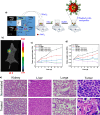In situ radiochemical doping of functionalized inorganic nanoplatforms for theranostic applications: a paradigm shift in nanooncology
- PMID: 40457312
- PMCID: PMC12128498
- DOI: 10.1186/s12951-025-03472-1
In situ radiochemical doping of functionalized inorganic nanoplatforms for theranostic applications: a paradigm shift in nanooncology
Abstract
In situ radiochemical doping presents a transformative approach for synthesizing radiolabeled inorganic nanoparticles (NPs) for cancer theranostics. Traditional radiolabeling techniques rely on bifunctional chelators, which often require harsh reaction conditions that can degrade the physicochemical properties of NPs. Additionally, the enzymatic dissociation of radiometals can potentially induce in vivo toxicity. In contrast, in situ doping directly incorporates radiometals into the NP crystal lattice, significantly enhancing both radiolabeling yield and radiochemical stability. This method preserves the pharmacokinetic profiles of the radiolabeled NPs, improving their theranostic efficacy. This review provides an up-to-date overview of the progress made in the development of radiolabeled inorganic nanoplatforms through in situ doping, with a focus on their stability, physicochemical characteristics, and applications in cancer theranostics. Our findings highlight the advantages in situ doping as a more efficient and stable alternative to conventional radiolabeling methods, offering substantial potential for the development of more effective cancer theranostic agents.
Keywords: Cancer; Doping; In situ; Nanoparticles; Precision oncology; Radiation therapy; Radiolabeling; Theranostics.
© 2025. The Author(s).
Conflict of interest statement
Declarations. Competing interests: Weibo Cai declares conflict of interest with the following corporations: Portrai, Inc., rTR Technovation Corporation, and Four Health Global Pharmaceuticals Inc. All other authors declare no competing of interest.
Figures

















Similar articles
-
Radiolabeling Silica-Based Nanoparticles via Coordination Chemistry: Basic Principles, Strategies, and Applications.Acc Chem Res. 2018 Mar 20;51(3):778-788. doi: 10.1021/acs.accounts.7b00635. Epub 2018 Feb 28. Acc Chem Res. 2018. PMID: 29489335 Free PMC article. Review.
-
Single Doping for Triple Functions: Integrated Theranostic Nanoplatforms for Multimodal Image-Guided Tumor Therapy.Adv Healthc Mater. 2023 Nov;12(28):e2301435. doi: 10.1002/adhm.202301435. Epub 2023 Sep 1. Adv Healthc Mater. 2023. PMID: 37611193
-
Preclinical and First-in-Human Study of a Compact Radionuclide Labeled Self-Assembly Nanomedicine for Chemo-Radio-Theranostics of Cancer.ACS Nano. 2025 Jan 28;19(3):3953-3965. doi: 10.1021/acsnano.4c18489. Epub 2025 Jan 13. ACS Nano. 2025. PMID: 39806279
-
Single Chelator-Minibody Theranostic Agents for 89Zr PET Imaging and 177Lu Radiopharmaceutical Therapy of PSMA-Expressing Prostate Cancer.J Nucl Med. 2024 Sep 3;65(9):1435-1442. doi: 10.2967/jnumed.124.267667. J Nucl Med. 2024. PMID: 39142831 Free PMC article.
-
Radiolabeling strategies and pharmacokinetic studies for metal based nanotheranostics.Wiley Interdiscip Rev Nanomed Nanobiotechnol. 2021 Mar;13(2):e1671. doi: 10.1002/wnan.1671. Epub 2020 Oct 12. Wiley Interdiscip Rev Nanomed Nanobiotechnol. 2021. PMID: 33047504
Cited by
-
Metal-based nanomedicines for cancer theranostics.Mil Med Res. 2025 Jul 30;12(1):41. doi: 10.1186/s40779-025-00627-x. Mil Med Res. 2025. PMID: 40739670 Free PMC article. Review.
References
Publication types
MeSH terms
Substances
LinkOut - more resources
Full Text Sources
Medical
Miscellaneous

